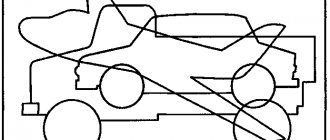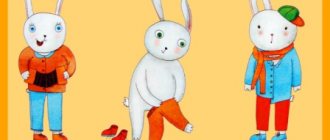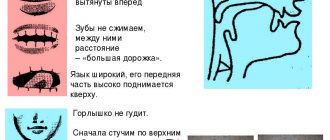MAGAZINE Preschooler.RF
G.V. Lomaga Teacher-speech therapist of the highest category MBDOU No. 19, head of the city methodological association of teachers of compensatory preschool educational institutions; Yuzhno-Sakhalinsk; graduated in 1998 Yuzhno-Sakhalin State Pedagogical Institute; Classes to overcome speech disorders are structured according to a specific system that takes into account the nature and severity of the defect, with mandatory consideration of the individual characteristics of the student. The main task of the work is the formation of mental operations on the word as a unit of speech, the development of an attentive attitude to the process of “speaking”. Two main areas of work can be distinguished: development and improvement of oral speech (pronunciation, vocabulary, grammar) and correction of written language disorders. In many ways, this work is propaedeutic, warning, in nature. For example, before starting to study parts of speech as part of a program in our native language, we try to learn to distinguish between them, as they say, in the flow of speech, i.e. on a practical level.I would like to present a summary of a speech therapy session. Goal: to introduce children to articulation exercises; talk about speech sounds; continue to introduce children to finger exercises and massage techniques; continue work on the prosodic components of speech; clarify lexical and grammatical concepts on the topic “Fruit”; teach children to form words using suffixes with diminutive and increasing disparaging meanings on the topic “Fruit”; remember general concepts; start introducing children to the syllabic structure of words; develop auditory attention, thinking, auditory and visual memory, and sense of smell. Equipment: speech sticks, mirrors (according to the number of children), cards with symbols of articulation exercises, pictures of fruits (large and small), a toy saucepan, fruits, cards with emotions (large and small), aroma lamp with orange or lemon oil, cards with numbers , doll, fruit bowl, board, cards for developing intonation. Progress of the lesson: 1. Organizational moment. (Standing). Greeting: Speech therapist: Listen more carefully and repeat after me. Good morning! Birds and animals! Good people, get out of bed, All the darkness has spread into the corners, The sun rises and goes home. Good morning to both the sun and the birds. Good morning to smiling faces!
-Smile at me and at each other. Say each person's name affectionately in turn.
2. Announcement of the topic and purpose of the lesson. L.: -Today we will get acquainted with Tongue’s house and we’ll also talk about this. Guess what. The one who guesses the riddles will sit down: *This yellow fruit grows Where it is summer all year round. He is like the edge of the moon. You all should know him! BANANA
*Grows in the garden, tastes like honey; Pick and eat, And it’s called... PEAR.
*Only in the south does it ripen, In a melon patch under a clear sky, And then it treats us with a sweet, fragrant slice. MELON
*A round, ruddy thing fell from a tree and got into the children’s mouths. APPLE
*Jam is as sunny as the south, There is a demand for pies with jam. In dried form it is apricot, and in natural form it is APRICOT.
- How, everything you mentioned is called in one word? (Fruits) - Today we’ll talk about them. (Sit down)
3. Lexico-grammatical exercise “COMPOT”.
The children went to the market and bought a lot of fruit there. Dad then asked them: “Who cooked what compote?”
L. – There are fruits in this pan. You will come up to the table one by one, with your eyes closed, take out the fruits and guess which fruit you took. And then tell me what kind of compote can be cooked from your fruit. (They answer with a complete answer: “I made a pear compote.”) - Now let’s cook a compote from 2 fruits (the speech therapist shows these fruits) (Pear - apple).
4. Finger gymnastics.
Playing with fingers (connecting fingers with pads, starting with the little fingers, one pair of fingers for each line of poetry; in this case, the palms do not touch each other).
We went to the market, Little fingers There are a lot of pears and persimmons, Unnamed There are lemons, oranges, Medium Melons, plums, tangerines, Index fingers But we bought a watermelon - Large This is the most delicious load! The fingers are clenched into a fist, and the thumb is pulled up.
5. Articulation gymnastics.
(Repeat the names of the organs of articulation, name and show them using a speech stick (with a mirror, without a mirror as demonstrated by the speech therapist, and without it - your choice).
L.: -Today we will go to visit Tongue. He lives in a house. This house is a mouth. Sounds live in it. Tell me, how many floors are there in the house? The first floor is the lower teeth. Point them out with the speech stick and touch them with your tongue. On the first floor there live vowel sounds: A O U Y Y E I. Name them again. There also lives a family of whistling sounds S Z S S Z Z C - repeat them. The second floor is the upper teeth - show them with a stick. There are also many sounds living here. Some of them like to hiss and are called hissing: Ш Ж Ш Ш. There are also sounds that love to sing sonorous songs - sonorous sounds - L L R R R'. L R sounds with a strong character; L'R - with soft. Let's name them. There are also other sounds on the second floor, but we will get acquainted with them in other classes. This is what a house of sounds is like. And the owner of this house...Tongue. A little later I will tell you the Tale of the Tongue. In the meantime...let's play.
6.Dynamic pause. Attention game "Orange, apple, banana." L.: - When I name fruits, we make the following movements: ORANGE - the thumb is connected into a ring with the index finger; APPLE - fist; BANANA – the palm of the hand is open. (You can confuse children - say plum, but show banana).
7. Lexico-grammatical exercise on the topic “Fruits”.
Exercises “Fruits for the doll.” L.: The doll Lena came to visit us. Let's treat her to fruit. To do this, you need to call them affectionately. (The speech therapist shows the children pictures, and they take turns calling them affectionately and putting them in a bowl (models of fruit).) The full answer: “I will treat the doll with an apple,” etc.
Game “What did the doll hide?” L.: - Look at the pictures. The doll wants to test how attentive you are. You close your eyes, the doll will remove one picture. And you tell me what picture she hid.
Game "Count" L.: -Help the doll count the fruits. (The speech therapist puts a picture with a number from 1-5 over the picture with the fruit and asks to make an answer according to the model (Five pears)).
Game "Carry On". L.: -The doll decided to compare the fruits with each other. Help her. Complete the sentences. The apple is big and the pineapple is…BIGGER. Orange is sour, but lemon is SOURER. The pear is juicy, but the tangerine is JUICIER.
8.Articulation gymnastics.
L.: - Once upon a time there was a tongue. he woke up early in the morning. Opened the WINDOW. I looked LEFT, RIGHT, DOWN to see if there were puddles, UP to see if there was sun. I closed the WINDOW - it became hot: AAA... I opened it again - it became cold: DDD... The tongue ran into the bathroom. I opened the door and the door creaked... “We need to lubricate the door,” thought Tongue. He turned on the water. First, hot water poured out. The tongue pulled back his hands “Oh!” Turned on the cold water. The hot water connected with the cold water and the water became warm SSS...Finally he began to brush his teeth. First the upper ones, then the lower ones (BRUSHING YOUR TEETH). I brushed my teeth, closed the creaky door III... And ran to the kitchen to bake pancakes. I started kneading the dough YA-YA-YA (lips), YA-YA-YA (teeth). Let's see if the dough is ready? (Use a cotton swab to check by “tingling” the tongue). No, it’s not ready. Knead the dough again and check. Ready! Baked Tongue Pancakes. I ate them with DELICIOUS JAM, washed them down with milk from a CUP. I looked at my WATCH. And I decided to go for a walk. There was a SWING in the yard. He swayed on it and moved on. You will find out what happened next in the next lesson.
9. Physical exercise “We shared the orange” (Get up from the chairs. Perform the appropriate movements) We shared the orange There were many of us, but he was alone
10. Work on prosody and breathing.
Exercise “Name the fruit affectionately” Introduce children to pictures-symbols of different emotions: Cheerful, Sad, Feisty, Little Surprised. Then invite the children to pronounce the fruits in the pictures with the appropriate intonation.
Exercise to develop breathing and smell. L.: -Guys, inhale air through your nose with your eyes closed and tell me what fruit smells in our room? (Orange or lemon - use an aroma lamp with the appropriate essential oils)
Exercise “Songs of vowel sounds” (for the development of speech exhalation) Conducted using cards. The speech therapist, while reading the poem, alternately shows the children cards and images of vowel sounds and their “songs.” The children must reproduce the corresponding song.
| Next > |
A game of attention.
Show your child the picture (when you click on the picture, it will appear in higher resolution. If you decide to print the picture, feel free to save it and send it for printing - it is designed for A4 format):
Ask to find all the same apples.
If you are lucky and have several varieties of different apples at home, then you can play this game with real apples.
"Description of Fruit"
Children: The apple is red, round in shape. The apple is big.
2.With orange skin,
Looks like a ball
But the center is not empty,
And juicy and tasty. (Orange)
(There is a picture of an orange on the board).
Educator: What is this? What color is the orange? What shape? What size? Do you think an orange is sweet or sour?
Children: Orange, round in shape...
3.It's almost like an orange
Thick skinned, juicy,
There is only one drawback -
Very, very sour (lemon)
(there is a picture of a lemon on the board).
Educator: What is this? What color is lemon? What shape is it? What size is a lemon?
Children: answer questions
4.Blue uniform, white lining,
It's sweet in the middle. (Plum.)
(on the board there is a picture of a plum).
Educator: What is this? What color is plum? What shape? What size is the plum?
Children: answer questions
5. A whole herd of horses on one leash. (Grape.)
Educator: What is this? What color are grapes? What shape? What size are the grapes?
Children: answer questions
Educator: I’m sitting on a tree, round like a ball,
Red as blood, sweet as honey. (Cherry.)
Educator: What is this? What color are cherries? What shape? What size is the cherry?
Children: Cherry is red, round in shape. Small cherry.
Educator: Well done, guys. All the riddles were solved.
Educator: Guys, how can you call an apple, orange, lemon in one word? What is this? Children: fruit.
Educator: Guys, where do fruits grow?
Children: in the trees
Educator: What are the names of the trees on which fruits grow?
Children: fruit
Educator: Where do fruit trees grow?
Children: in the garden.
Educator: What is the name of a garden in which there are many fruit trees?
Children: orchard
Educator: Well done! The Hedgehog and the Little Fox are also happy with you.
Physical school
Educator: Let's rest a little. Leave the tables and come to me. Stand in a circle. And we will put the Hedgehog and the Little Fox in the center of the circle.
Children: Go out to the teacher’s carpet and stand in a circle.
“Yesterday we walked in the garden, They walk in a circle, holding hands.
We planted currants. They depict how they dig a hole and plant a bush in it.
We whitened the apple tree with lime and whitewash. Move your right hand up and down.
We fixed the fence. Simulates hitting with a hammer.
We started a conversation: They stand facing in a circle
- Tell me, our gardener,
What will you give us as a reward? One finger is bent for each name.
I will give you lilac plums and honey pears as a reward,
The largest ripe apples, They stretch their hands forward.
A whole kilogram of cherries
This is what I will give you as a reward.
A whole kilogram of cherries, that's what I'll give you as a reward.
Coloring stencils.
You can start painting apples. And so that at the end of the work we get a real masterpiece with neat, even edges, a stencil will help us:
Since kids will be coloring the apple, the stencil will need to be firmly attached to a sheet of paper with a stapler or tape.
Before you start coloring, you can put a real apple in front of your baby and learn to color “from life.” (But not all children under 3 or even 4 years old are able to grasp the meaning of coloring “from nature” - for this you need to “mature”).
Logical chains.
Logical chains is a game for older children. But with a child from 2 to 3 years old, you can try to arrange consecutive pictures together and talk about “what comes after what.” On the topic of fruits, I found the following logical chains:
You can download them by clicking on the picture.



